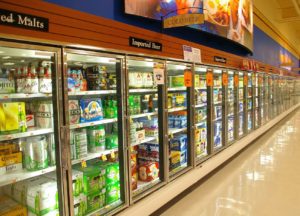 A small amount of refrigeration is essential for any modern community.
A small amount of refrigeration is essential for any modern community.
Although it uses more energy long-term than any other method of preservation, it is critical for storage of many important medical supplies, at the very minimum.
Having no access to refrigeration also mean that day-to-day food preperation results in more waste, as it must be consumed within a limited amount of time.
Simple techniques such as having the opening of the refrigerator on the top instead of a swinging door can dramatically reduce the energy loss when opening and closing a fridge. //////////and better insulation and construction principles.
Freezing, while being an excellent preservation method, requires a temperature of -18c and is to be avoided for long term storage unless abundant surplus of reliable renewable energy is available, or a greater investment in insulation is made during construction.
Compression Refrigeration (Common)
Compression refrigeration is the most widely used cooling method, for such purposes as air conditioning, truck and rail cars, industrial purposes, and your home refrigerator.
When gasses change pressure, the also change temperature. At a basic level, compression refrigeration operates by compressing gas and routing it so the cool gas is inside your refrigerator and the warmer gas is outside.
There are several types of compressors that can do this, but the principle is the same.
- Very mature technology.
- Relatively inexpensive.
- Can be driven directly using mechanical energy (water, car/truck motor) or with electrical energy.
- Efficient up to 60% of Carnot’s theoretical limit
- It is possible to use carbon dioxide as the gas involved for a sacrifice of efficiency
- scalable
- older systems use HCFCs – which damage the ozone layer
- newer systems can use HFCs – which have an extremely large global warming potential
- ammonia is an option – it is toxic and incompatible with copper pipes – but also creates little pollution
Absorption refrigeration
Absorption refrigeration is probably the most efficient method that currently exists when the goal is sustainability, and it is combined with other sustainable activities.
- Can harness the waste heat of other systems ie. solar heating or engine coolant.
- No electricity required depending on power source
- Silent with no moving parts
- Reduced vaporization pressure & temperature
- Very low maintenance
- Capacity control – when load is low, power usage is low
- Running costs very low
- no CFCs or HCFCs required
- takes longer to produce a cooling effect
- Initial capital cost is relatively high
Ammonia absorption refrigeration systems can be built with no moving parts and can require no work input. They operate with a heat input only. Ammonia absorption refrigerators are used industrially and in recreational vehicles. – Learnthermo.com
Thermoelectric Refrigeration
Thermoelectric Refrigerators operate using the Peltier effect.
- No moving parts so maintenance is required less frequently
- No chlorofluorocarbons involved
- Low cost
- Temperature control to within fractions of a degree can be maintained
- Scalable to very small size (compact)
- Can be used in environments that are smaller or more severe than conventional refrigeration
- Has a long life, with mean time between failures exceeding 100,000 hours
- Only a limited amount of heat flux is able to be dissipated
- Not as efficient, in terms of coefficient of performance, as vapour-compression systems or absorption systems
Natural Evaporation Refrigeration
When a liquid evaporates it loses energy. This is why sweating cools us down. The sweat on our skin evaporates and it takes a bit of energy from our skin with it. This loss of energy provides us with a cooling effect.- RebuildingCivilisation.com
Evaporative coolers have been around since as early as 2500 B.C.
- No moving parts
- Totally sustainable
- Very low cost
- Long lasting
- Very easy to build
- Compact
- Only a limited amount of heat dissipated
- Doesn’t function when high ambient humidity prevents evaporation
- Only lowers temperature as a fraction of ambient temperature
https://en.wikipedia.org/wiki/Coolgardie_safe
Zeer Pot Fridge (pot-in-pot)
The principle of the pot-in-pot style evaporative cooler is simple. One pot is placed inside another, with a layer of sand or other inorganic material filling the space between the two.
The sand is then soaked with water, which slowly evaporates through the slightly porous earthenware or terracotta. As long as the pots are unglazed and allow water to “wick” through them, any kind of earthenware can be used.
According to Science In Africa, each device can store 12kg of vegetables, keeping them fresh for up to 20 days while costing less than 2USD to produce.
Zeer pots are excellent for extending the life of fruits and vegetables, but are only highly efficient in use of energy and materials – not in terms of reliable refrigeration.
Traditional evaporative fridge
There are many possible designs for basic evaporative fridges.
The concept is very basic. A frame or container is walled with fabric or material of some kind. This material is kept moist, using either gravity or wicking to draw water from a small reservoir.
Simple and easy to construct, evaporative fridges can substantially increases the lifespan of your produce for minimal investment, and can be built using discarded or recycled materials.
Radiative cooling
// under construction
Root Cellars
Root cellars are the most ancient form of natural refrigeration, using the earth itself as a heat sink to keep cool.
// under construction
Learn More >>
Absorption refrigeration @ Wikipedia.
Thermoelectric refrigeration @ Wikipedia
A brief overview of how absorption refrigeration works @ DavidDarling.info
A detailed technical overview and review of absorption refrigeration .PDF @ ResearchGate.net
Operating principles of compression refrigeration @ Youtube
Natural evaporation refrigeration stats and efficiency @ RebuildingCivilisation.com
Links and history of the refrigerator @ Inventors.about.com
Alternative refrigeration @ ProvidentLivingToday.com
Zeer Pot fridge details and information @ Appropedia.org
